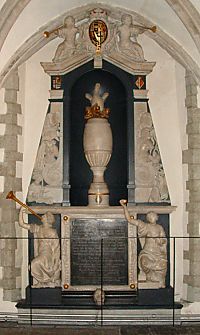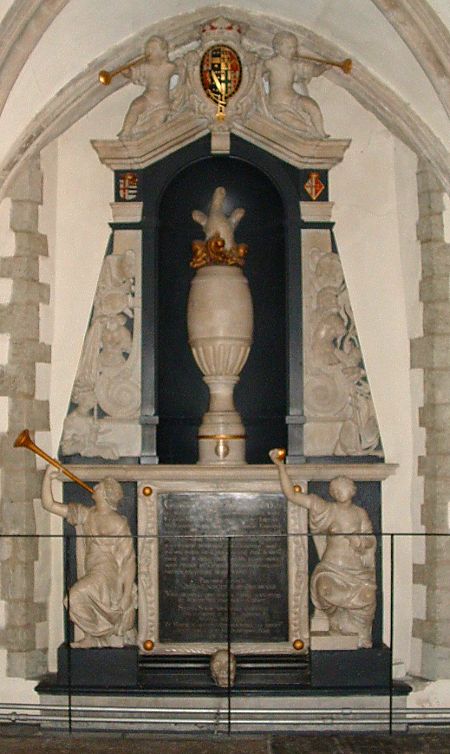Location
On the south side of the Chapel of St. Thomas (see Cathedral Plan).
To such a man, born to everything of greatest worth, Susanna his sister, countess of Denbigh, in tears and everlasting grief, erected this monument in the year 1631. His bowls, together with hers, are buried here. You, traveller, if you have any bowels of pity, groan with indignation at such unworthy fate of so great a man, and so depart.'
Further Information
George Villiers, later Duke of Buckingham, was born the son of a lesser knight in Leicestershire. He was first introduced to the court of James I in 1614 and quickly achieved high rank through attracting the King's favour. Buckingham solidified his place at court by befriending the young Prince Charles and encouraging him to court the Infanta of Spain. In 1623 the two of them travelled to Spain and returned good friends.
Buckingham saw his role as a defender of the nation but his reputation took a setback when his first expedition to Cadiz proved to be a disaster. Buckingham did not accompany the fleet but the commissary general, John Mason did, earning a meritorious reputation in the process. Mason was promoted by Buckingham and they became allies. Mason further provided Buckingham with the organisational skills needed for the next expedition, this time to La Rochelle, which also ended in disaster.
In the early part of the 17th century the navy was in a poor state but neither parliament nor the king were willing, or able, to provide the necesssary resources to bring it to a state of good repair. Mason did his best with the limited funds available but even he could not find the cash to pay the sailors or soldiers and as head of the forces Buckingham received a lot of the criticism for this. One young man, John Felton, believed that things could not improve whilst the Duke lived and on the 23rd August 1628 travelled to Portsmouth and found his way to John Mason's house at No. 11 High Street where the Duke of Buckingham was staying.
There were a great many people in the house that morning, such that Felton's presence would have gone unnoticed. The Duke was in a fine mood and as he was about to leave the house he met Sir Thomas Fryer and as they exchanged bows Felton stabbed Buckingham before melting away into the crowd.
The Duke of Buckingham was later buried in splendour in Westminster Abbey.
The house in which the Duke was assassinated lies 200 metres East along the High Street. See the plaque outside the house in the Old Portsmouth section.
John Mason is also commemorated on plaques in the Royal Garrison Church and in the Cathedral.


